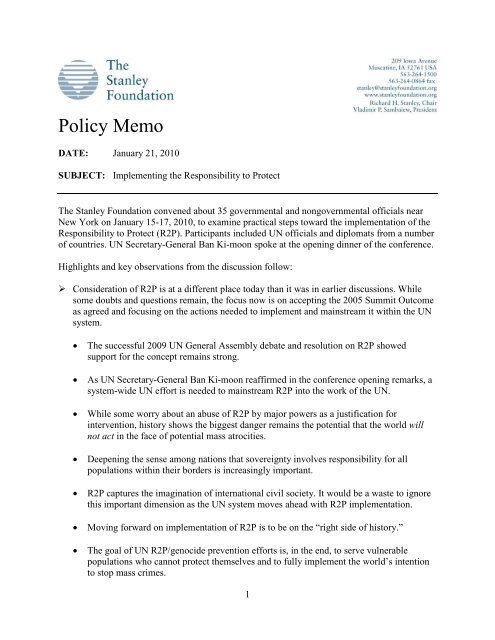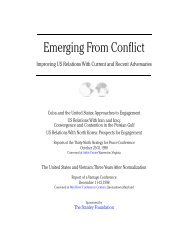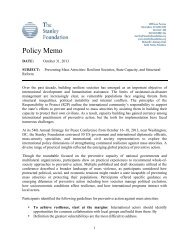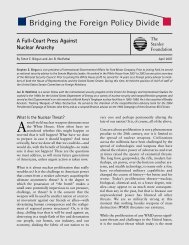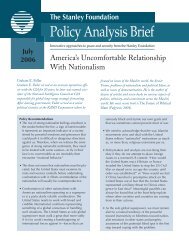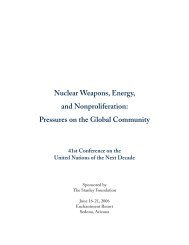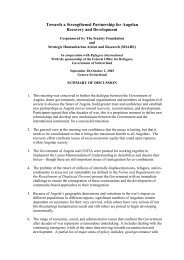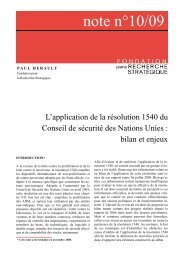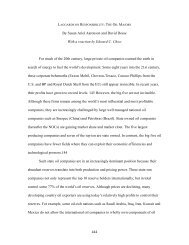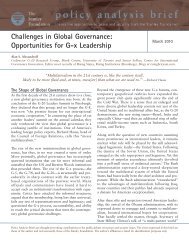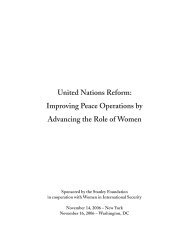Policy Memo - The Stanley Foundation
Policy Memo - The Stanley Foundation
Policy Memo - The Stanley Foundation
Create successful ePaper yourself
Turn your PDF publications into a flip-book with our unique Google optimized e-Paper software.
<strong>Policy</strong> <strong>Memo</strong>DATE: January 21, 2010SUBJECT: Implementing the Responsibility to Protect<strong>The</strong> <strong>Stanley</strong> <strong>Foundation</strong> convened about 35 governmental and nongovernmental officials nearNew York on January 15-17, 2010, to examine practical steps toward the implementation of theResponsibility to Protect (R2P). Participants included UN officials and diplomats from a numberof countries. UN Secretary-General Ban Ki-moon spoke at the opening dinner of the conference.Highlights and key observations from the discussion follow:‣ Consideration of R2P is at a different place today than it was in earlier discussions. Whilesome doubts and questions remain, the focus now is on accepting the 2005 Summit Outcomeas agreed and focusing on the actions needed to implement and mainstream it within the UNsystem.• <strong>The</strong> successful 2009 UN General Assembly debate and resolution on R2P showedsupport for the concept remains strong.• As UN Secretary-General Ban Ki-moon reaffirmed in the conference opening remarks, asystem-wide UN effort is needed to mainstream R2P into the work of the UN.• While some worry about an abuse of R2P by major powers as a justification forintervention, history shows the biggest danger remains the potential that the world willnot act in the face of potential mass atrocities.• Deepening the sense among nations that sovereignty involves responsibility for allpopulations within their borders is increasingly important.• R2P captures the imagination of international civil society. It would be a waste to ignorethis important dimension as the UN system moves ahead with R2P implementation.• Moving forward on implementation of R2P is to be on the “right side of history.”• <strong>The</strong> goal of UN R2P/genocide prevention efforts is, in the end, to serve vulnerablepopulations who cannot protect themselves and to fully implement the world’s intentionto stop mass crimes.1
‣ While early warning about the relevant crimes is always vital, there is significant agreementthat assessment and turning information into actionable intelligence are equally critical andan even greater challenge. A focal point is needed for this information flow and assessment,and the joint office proposed by the secretary-general seems a logical place.• <strong>The</strong> joint office would be in the Secretariat and accountable to the secretary-general.• <strong>The</strong> assessed information, as well as response options, would flow naturally to thesecretary-general. He, in turn, is in the best position to decide where and when thisinformation should go, whether the General Assembly, Security Council, Human RightsCouncil, ECOSOC, Peacebuilding Commission, regional or subregional arrangements, orothers.• Gathering sufficient advance information (early warning) on potential R2P situations canbe difficult, especially in cases of failing states or where the national government is theinstigator.• Information from all sources is likely to be challenged. UN political will to deal with R2Pcrises is even more important as a result.‣ Establishing and supporting the proposed joint office received considerable support amongconference participants and this should be carried forward in the appropriate UN bodies. <strong>The</strong>joint office’s mandates should be integrated and any definitional deficiencies remedied.• A joint office on R2P/genocide prevention has positive “delivering as one” dimensions.• <strong>The</strong> joint office is seen as a way to overcome bureaucratic territorial issues that too oftenwork against getting effective policy recommendations to the secretary-general.• Early consultations argue for a lean and agile joint office staffed by senior officials.• <strong>The</strong> use of other standing or ad hoc groups (in connection with the joint office) tobroaden the policy advice the secretary-general receives in this area should be hismanagement decision.• Adequate funding for the joint office is essential. Participants suggested that the officeshould ultimately be funded within the normal budget process since it is a necessarycontinuing function. However, trust funds could be used as a transition into the normalbudget or as additional funding to support specific activities of the office.‣ <strong>The</strong> primary leadership for implementing R2P within the UN system necessarily falls on theshoulders of the secretary-general. His role is to lead and direct, using existing structureswhere possible.2
• <strong>The</strong> secretary-general should use his management latitude to decide how to structure thejoint office and working arrangements with his advisors and among various departmentsand organizational units.• As the secretary-general continues his consultations and thinking about how the jointoffice and advisory group will work, a concept paper from his office would be useful inadvancing the conversation and reassuring all involved.• <strong>The</strong> secretary-general should be asked to present periodic reports on implementationprogress to facilitate General Assembly oversight.Full Report to FollowA more comprehensive report about this conference and its major recommendations will follow ina few weeks.<strong>The</strong> analysis and recommendations included in this <strong>Policy</strong> <strong>Memo</strong> do not necessarilyreflect the view of the <strong>Stanley</strong> <strong>Foundation</strong> or any of the conference participants, butrather draw upon the major strands of discussion put forward at the event. Participantsneither reviewed nor approved this document. <strong>The</strong>refore, it should not be assumed thatevery participant subscribes to all of its recommendations, observations, and conclusions.For further information, please contact Keith Porter at the <strong>Stanley</strong> <strong>Foundation</strong>,563-264-1500.About <strong>The</strong> <strong>Stanley</strong> <strong>Foundation</strong><strong>The</strong> <strong>Stanley</strong> <strong>Foundation</strong> seeks a secure peace with freedom and justice, built on worldcitizenship and effective global governance. It brings fresh voices, original ideas, andlasting solutions to debates on global and regional problems. <strong>The</strong> foundation is anonpartisan, private operating foundation, located in Muscatine, Iowa, that focuses onpeace and security issues and advocates principled multilateralism. <strong>The</strong> foundationfrequently collaborates with other organizations. It does not make grants. Online atwww.stanleyfoundation.org.3


